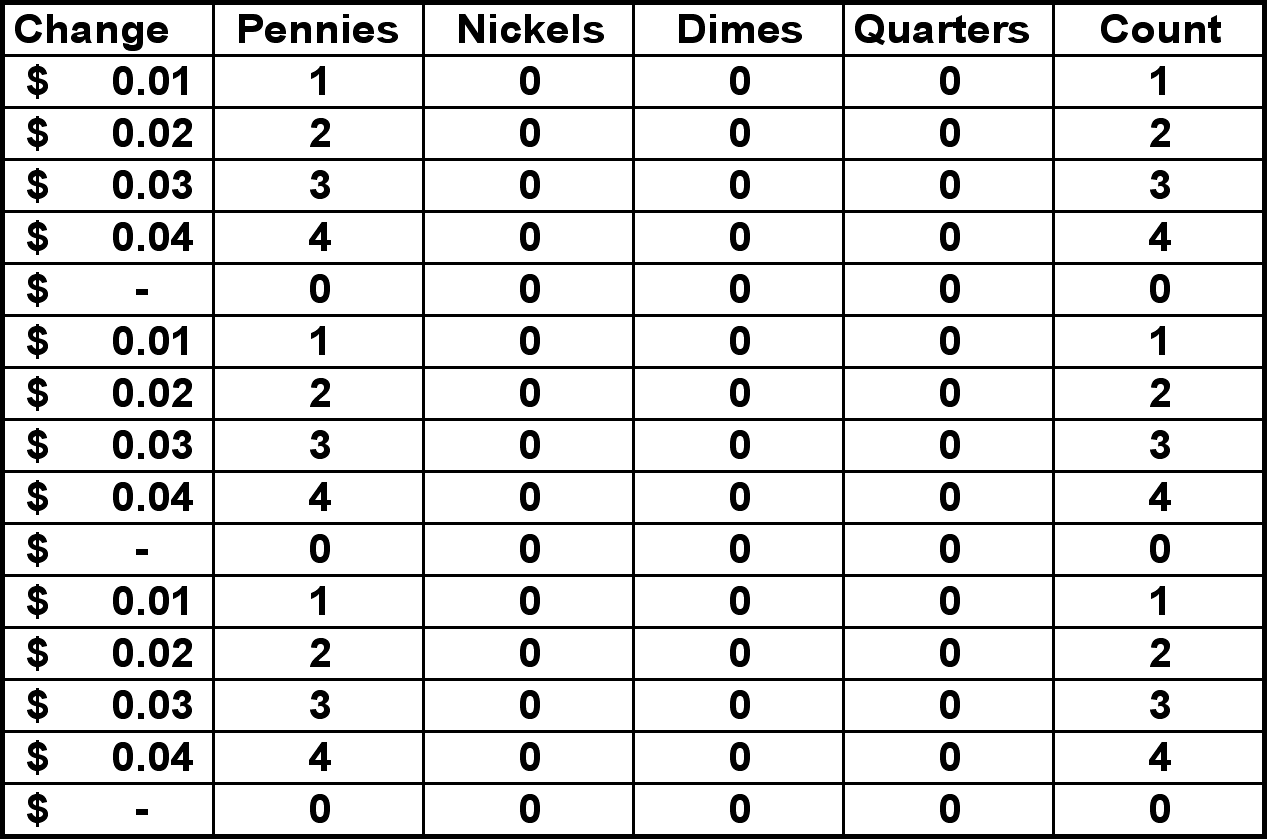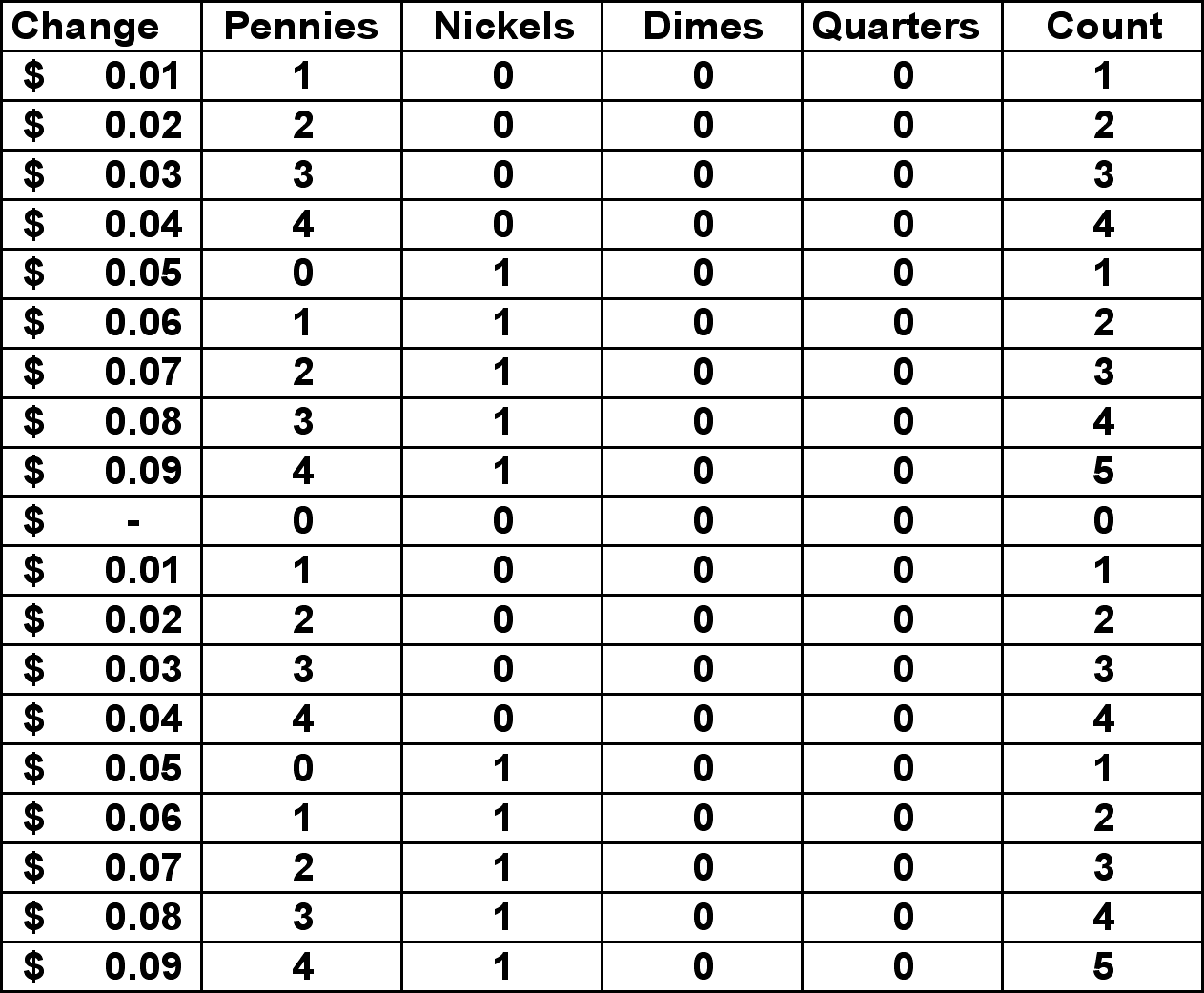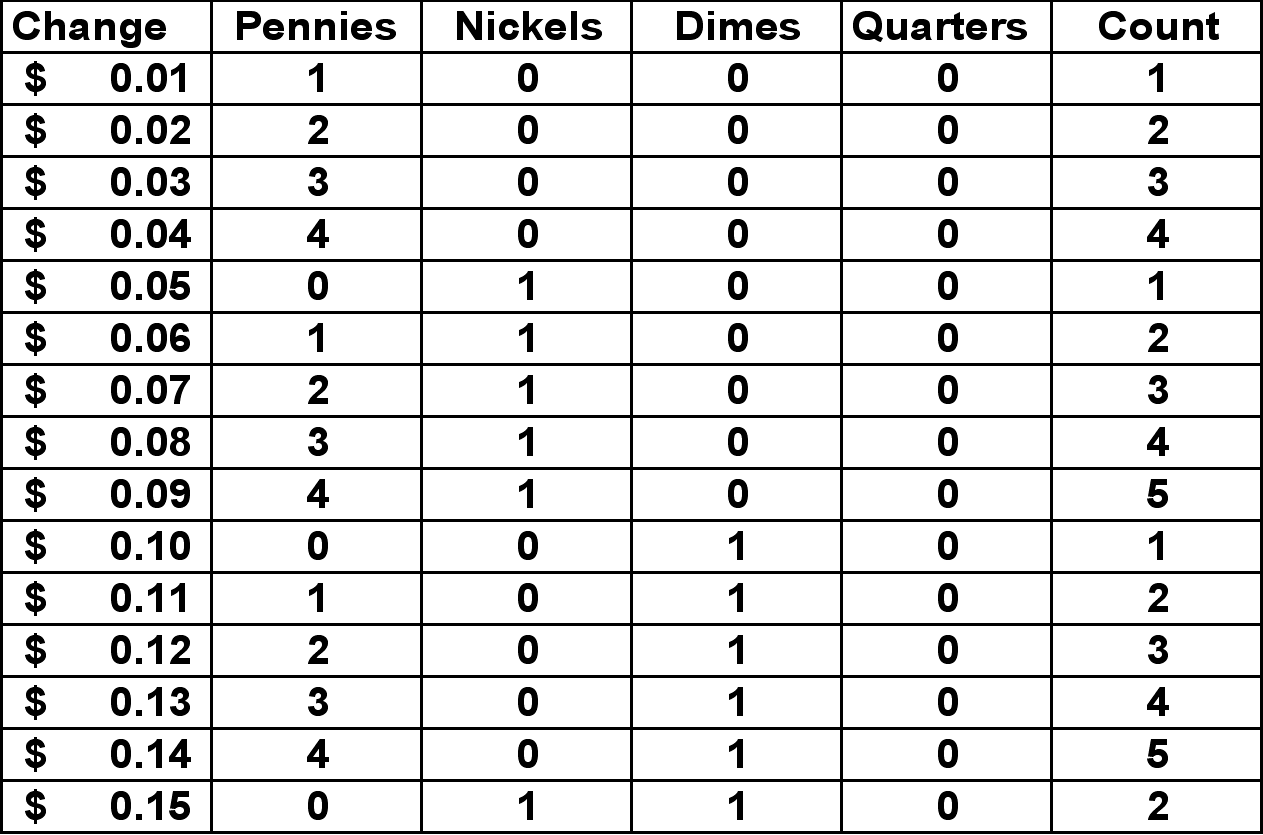The spreadsheet allows us to quickly repeat tables and search functions throughout a table to sift through all combinations of a problem and point out a solution. In the case above, create a spreadsheet of the number of coins necessary to get to $0.25 and then can repeat the sequence over again 3 times to get the least number of coins for each value of change.
We would start with a spreadsheet with the value of the change in the first column (A), the numbers of pennies in the next column(B), number of nickels in column C, the number of dimes in column D and the number of quarters in column E.
The value we enter in A is a calculation:
=0.01<B1> + 0.05 <C1> + 0.10<D1> + 0.25<E1
Initially we would clear out all of the values in columns B, C, D and E and add values as we increas total change we're counting.
Column B would be populated with 1, 2, 3, 4, 0, in sequence until we reached 20 cycles of this. This is the penny column and we need to increment between the other coins.

Column C would be 0 to start, go to 1 at $0.05; go back to 0 at $0.10, back to 1 at $0.15, back to 0 at $0.20 and stay 0 through $0.25.
Note: This will give us a different result than was presented in the first approach. This will result in 2 dimes and 1 nickel being used. In the other approach, we ended up with 1 dime and 2 nickels.

Column D would be 0 to start, go to 1 at $0.10; increment to 2 at $0.20 and go back to 0 at $0.25.

After the first 25 cycles, columns B, C and D repeat the same cycles for 26 through 50, 51 through 75 and 76 through 100.
Column E, would be 0 for cycles 0-24; increment to 1 at cycle 25; stay at 1 through cycle 49; increment to 2 at cycle 50; stay at 2 through 74; increment to 3 at cycle 75 and stay at 3 through cycle 99.
| Change | Pennies | Nickels | Dimes | Quarters | Count |
| 0.01 | 1 | 0 | 0 | 0 | 1 |
| 0.02 | 2 | 0 | 0 | 0 | 2 |
| 0.03 | 3 | 0 | 0 | 0 | 3 |
| 0.04 | 4 | 0 | 0 | 0 | 4 |
| 0.05 | 0 | 1 | 0 | 0 | 1 |
| 0.06 | 1 | 1 | 0 | 0 | 2 |
| 0.07 | 2 | 1 | 0 | 0 | 3 |
| 0.08 | 3 | 1 | 0 | 0 | 4 |
| 0.09 | 4 | 1 | 0 | 0 | 5 |
| 0.1 | 0 | 0 | 1 | 0 | 1 |
| 0.11 | 1 | 0 | 1 | 0 | 2 |
| 0.12 | 2 | 0 | 1 | 0 | 3 |
| 0.13 | 3 | 0 | 1 | 0 | 4 |
| 0.14 | 4 | 0 | 1 | 0 | 5 |
| 0.15 | 0 | 1 | 1 | 0 | 2 |
| 0.16 | 1 | 1 | 1 | 0 | 3 |
| 0.17 | 2 | 1 | 1 | 0 | 4 |
| 0.18 | 3 | 1 | 1 | 0 | 5 |
| 0.19 | 4 | 1 | 1 | 0 | 6 |
| 0.2 | 0 | 0 | 2 | 0 | 2 |
| 0.21 | 1 | 0 | 2 | 0 | 3 |
| 0.22 | 2 | 0 | 2 | 0 | 4 |
| 0.23 | 3 | 0 | 2 | 0 | 5 |
| 0.24 | 4 | 0 | 2 | 0 | 6 |
| 0.25 | 0 | 0 | 0 | 1 | 1 |
| 0.26 | 1 | 0 | 0 | 1 | 2 |
| 0.27 | 2 | 0 | 0 | 1 | 3 |
| 0.28 | 3 | 0 | 0 | 1 | 4 |
| 0.29 | 4 | 0 | 0 | 1 | 5 |
| 0.3 | 0 | 1 | 0 | 1 | 2 |
| 0.31 | 1 | 1 | 0 | 1 | 3 |
| 0.32 | 2 | 1 | 0 | 1 | 4 |
| 0.33 | 3 | 1 | 0 | 1 | 5 |
| 0.34 | 4 | 1 | 0 | 1 | 6 |
| 0.35 | 0 | 0 | 1 | 1 | 2 |
| 0.36 | 1 | 0 | 1 | 1 | 3 |
| 0.37 | 2 | 0 | 1 | 1 | 4 |
| 0.38 | 3 | 0 | 1 | 1 | 5 |
| 0.39 | 4 | 0 | 1 | 1 | 6 |
| 0.4 | 0 | 1 | 1 | 1 | 3 |
| 0.41 | 1 | 1 | 1 | 1 | 4 |
| 0.42 | 2 | 1 | 1 | 1 | 5 |
| 0.43 | 3 | 1 | 1 | 1 | 6 |
| 0.44 | 4 | 1 | 1 | 1 | 7 |
| 0.45 | 0 | 0 | 2 | 1 | 3 |
| 0.46 | 1 | 0 | 2 | 1 | 4 |
| 0.47 | 2 | 0 | 2 | 1 | 5 |
| 0.48 | 3 | 0 | 2 | 1 | 6 |
| 0.49 | 4 | 0 | 2 | 1 | 7 |
| 0.5 | 0 | 0 | 0 | 2 | 2 |
| 0.51 | 1 | 0 | 0 | 2 | 3 |
| 0.52 | 2 | 0 | 0 | 2 | 4 |
| 0.53 | 3 | 0 | 0 | 2 | 5 |
| 0.54 | 4 | 0 | 0 | 2 | 6 |
| 0.55 | 0 | 1 | 0 | 2 | 3 |
| 0.56 | 1 | 1 | 0 | 2 | 4 |
| 0.57 | 2 | 1 | 0 | 2 | 5 |
| 0.58 | 3 | 1 | 0 | 2 | 6 |
| 0.59 | 4 | 1 | 0 | 2 | 7 |
| 0.6 | 0 | 0 | 1 | 2 | 3 |
| 0.61 | 1 | 0 | 1 | 2 | 4 |
| 0.62 | 2 | 0 | 1 | 2 | 5 |
| 0.63 | 3 | 0 | 1 | 2 | 6 |
| 0.64 | 4 | 0 | 1 | 2 | 7 |
| 0.65 | 0 | 1 | 1 | 2 | 4 |
| 0.66 | 1 | 1 | 1 | 2 | 5 |
| 0.67 | 2 | 1 | 1 | 2 | 6 |
| 0.68 | 3 | 1 | 1 | 2 | 7 |
| 0.69 | 4 | 1 | 1 | 2 | 8 |
| 0.7 | 0 | 0 | 2 | 2 | 4 |
| 0.71 | 1 | 0 | 2 | 2 | 5 |
| 0.72 | 2 | 0 | 2 | 2 | 6 |
| 0.73 | 3 | 0 | 2 | 2 | 7 |
| 0.74 | 4 | 0 | 2 | 2 | 8 |
| 0.75 | 0 | 0 | 0 | 3 | 3 |
| 0.76 | 1 | 0 | 0 | 3 | 4 |
| 0.77 | 2 | 0 | 0 | 3 | 5 |
| 0.78 | 3 | 0 | 0 | 3 | 6 |
| 0.79 | 4 | 0 | 0 | 3 | 7 |
| 0.8 | 0 | 1 | 0 | 3 | 4 |
| 0.81 | 1 | 1 | 0 | 3 | 5 |
| 0.82 | 2 | 1 | 0 | 3 | 6 |
| 0.83 | 3 | 1 | 0 | 3 | 7 |
| 0.84 | 4 | 1 | 0 | 3 | 8 |
| 0.85 | 0 | 0 | 1 | 3 | 4 |
| 0.86 | 1 | 0 | 1 | 3 | 5 |
| 0.87 | 2 | 0 | 1 | 3 | 6 |
| 0.88 | 3 | 0 | 1 | 3 | 7 |
| 0.89 | 4 | 0 | 1 | 3 | 8 |
| 0.9 | 0 | 1 | 1 | 3 | 5 |
| 0.91 | 1 | 1 | 1 | 3 | 6 |
| 0.92 | 2 | 1 | 1 | 3 | 7 |
| 0.93 | 3 | 1 | 1 | 3 | 8 |
| 0.94 | 4 | 1 | 1 | 3 | 9 |
| 0.95 | 0 | 0 | 2 | 3 | 5 |
| 0.96 | 1 | 0 | 2 | 3 | 6 |
| 0.97 | 2 | 0 | 2 | 3 | 7 |
| 0.98 | 3 | 0 | 2 | 3 | 8 |
| 0.99 | 4 | 0 | 2 | 3 | 9 |
Once the columns are all filled, and we've checked the value of $'s in column A, we can check for the minimum number of coins needed....
At the end of each of the columns B through E, we will use the maximum function to determine the maximum number of coins we needed to use to get all the change values. The function entered will look like:
=MAX(B2:B100)
Where B2:B100 is the range of cells where the number of pennies are entered. Once the entry is made for column B, it can be copied to columns C, D and E.
| Change | Pennies | Nickels | Dimes | Quarters | Count |
| 0.91 | 1 | 1 | 1 | 3 | 6 |
| 0.92 | 2 | 1 | 1 | 3 | 7 |
| 0.93 | 3 | 1 | 1 | 3 | 8 |
| 0.94 | 4 | 1 | 1 | 3 | 9 |
| 0.95 | 0 | 0 | 2 | 3 | 5 |
| 0.96 | 1 | 0 | 2 | 3 | 6 |
| 0.97 | 2 | 0 | 2 | 3 | 7 |
| 0.98 | 3 | 0 | 2 | 3 | 8 |
| 0.99 | 4 | 0 | 2 | 3 | 9 |
| Maximum | 4 | 1 | 2 | 3 | 10 |
As can be seen, we can then sum up the total of the max's for each coin to determine the total number of coins needed.